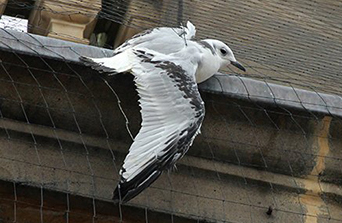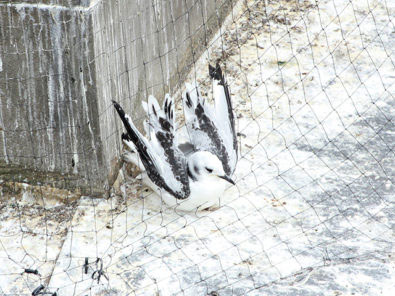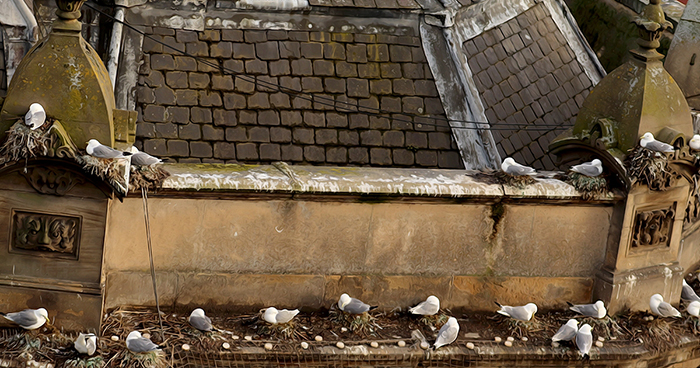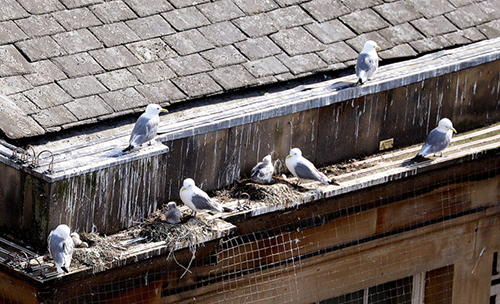
“Have you found an injured
or trapped Kittiwake along the Tyne?”
Not everyone is keen to host a colony of nesting Kittiwakes; with many concerned about any noise and waste produced during their time with us every spring and summer.
“Building owners and local councils install anti-bird deterrents
in an attempt to deter birds from nesting“.
Netting
A variety of netting is used to attempt to prevent or persuade birds from nesting by blocking off specific areas on buildings. Evidence has proved, that this method regularly fails to stop birds nesting; however as they attempt to nest on top of netting or as netting becomes damaged over time, birds can become fatally trapped in the netting.
“In 2018 on the Quaysides of Newcastle upon Tyne and Gateshead there were over twenty Kittiwake casualties as a result of anti-bird netting installed on several buildings. Following a local campaign, netting was removed”.

A Tyne Kittiwake Trapped in anti-bird netting during
the 2018 breeding season on Newcastle Quayside by Paul Buskin
This new group; Kittiwakes upon the Tyne now exists to help raise their voice to look out for the local colonies of Kittiwakes along the River Tyne.
Spikes
Long sharp spikes, that spoil the visual appearance of buildings. Evidence has shown that these in many cases fail to prevent birds nesting; as in the photo below from the Brunswick Shopping Centre in Scarborough, they often use the spikes to build their nest on. Birds do become injured however, as the interact with the spikes; at times fatally.

Kittiwakes in Scarbrough nesting on Anti-bird spikes on the Brunswick Shopping Centre during the 2023 season.
Fire Gel
To a bird the harmless (and invisible to the human eye) Ultra Violet (UV) light projecting from the non-toxic Gel is seen as a flame and hence a hazard to avoid. There is some evidence this causes birds to react initially and avoid the areas where it is present more. However, over time their desire to nest overcomes such fears and they nest amongst the tubs of anti-bird gel; often without any reduction in numbers that year.

Kittiwakes nesting on Phoenix House on Newcastle Quayside, amongst anti-bird gel.
Avishock
Low voltage electric deterrent which delivers a harmless but disconcerting electric pulse. This modifies the birds’ behaviour by stimulus rather than by installing a physical barrier. Does this work? Are there risks when it is turned on? Observations by members of Kittiwakes upon the Tyne, have revealed no evidence of any harm to any birds.
However, the Avi-shock needs to be On or Off? as once Kittiwakes start nesting, there could be risks to the Kittiwakes and their young if they choose to nest on top of it.

Kittiwakes nesting on The Guildhall On Newcastle Quayside on top of Avi-shock
Fake Raptors
Model birds of prey installed on buildings. These never stop Kittiwakes from nesting, but they can make a useful perch to relax on top of.
Guidance on Anti-bird Deterrents
The safe and informed use of deterrents to prevent Kittiwakes landing and nesting
on buildings and structures in Newcastle City.




















